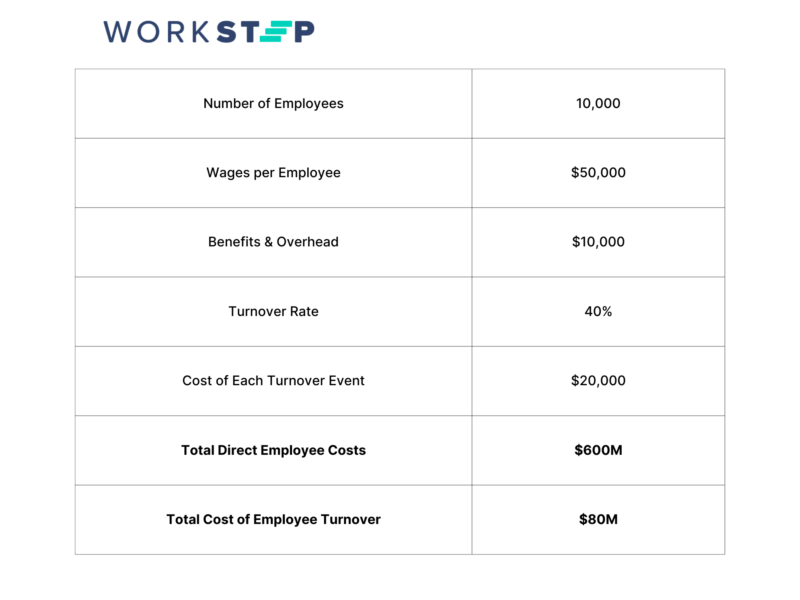Between critical labor shortages, meeting the needs of a new generation of workers, and an uncertain macroeconomic environment, times are hard for everyone. This was especially true across traditional frontline and blue collar verticals, like manufacturing and logistics. Talent screening bars were bent or completely forgotten, job advertising budgets went through the roof, and most companies were doing everything they could to hire the talent they needed to meet customer demand.
Post 2020, the labor market had cooled, the pace of hiring had slowed, and companies were thus able to focus on better managing the talent that they have. As we head into 2024, in the face of an uncertain economy, most CFOs are eyeing cost savings rather than growth.
In the quest for these savings, labor is a natural first place to look. After all, below COGS, it’s typically a company’s largest line item.
Here is how labor expense breaks down for a typical supply chain company:
 In the current inflationary environment, paring back wages and benefits is generally untenable, which should lead CFOs and Operations leaders to look to address their cost of turnover. After all, employee turnover is millions of dollars leaving your bottom line.
In the current inflationary environment, paring back wages and benefits is generally untenable, which should lead CFOs and Operations leaders to look to address their cost of turnover. After all, employee turnover is millions of dollars leaving your bottom line.
It’s no secret that employees, especially those who work on the frontline, are voting with their feet and leaving employers at rates we’ve never before seen in the history of our country. Increasing turnover rates coupled with an increasing cost of employee replacement, driven by low unemployment and structural skill shortages, are an expensive combination.
But this upswing in employee turnover costs can be reversed by following the below 5 steps.
Step 1: Commit to an employee turnover reduction goal
Before an organization can drive employee turnover down, which of course pushes turnover expense down, one needs to commit to a goal across the company. Assuming turnover in 2022 was 40%, as shown above, decreasing that to 35% would save $10M/year.
An explicit goal is critical for a few reasons:
- It aligns finance, operations and HR on a shared goal that can be tackled together.
- It helps create the ROI case for incremental investments, if any. If target savings are $10M, an organization can feel comfortable making relatively small investments in service of this target.
- It provides accountability. By establishing where a team is trying to go, it creates a framework through which to check in on pacing and progress.
Step 2: Collect employee feedback
The temptation with a turnover reduction goal, is to immediately jump into action planning.
What if we introduced flexible scheduling? What if we did more employee recognition? Could education benefits be impactful?
The truth is that these debates, at a leadership level, are useless at best and counterproductive at worst. To build conviction around how best to improve the employee experience, a company needs to empower the voice of their associates.
Automated, ongoing feedback collection at scale provides a company of any size with the employee sentiment data necessary to make informed decisions related to workforce turnover.
Step 3: Narrow in on new hires
Solving overall employee turnover starts with solving new employee turnover. Most companies that we talk to see that the majority of all employee turnover events happen within the first 90 days of employment.
The good news is that this skew toward new employee turnover means that leadership teams can truly focus on this key group of teammates. It is critical to ensure that new employees are onboarded thoughtfully, and also able to provide feedback throughout their ramp up period.
Best practice is that new hires have the opportunity to provide both in-person feedback, as well as anonymous feedback, at least twice in their first month, and then at least two more times during their first quarter with a company.
By nipping any issues in the bud during this critical employment period, companies are able to reduce new hire turnover rates by over 20%. That’s 20% less new hires who walk out the door before becoming fully productive, taking their cost of sourcing and cost of training with them.
Step 4: Understand turnover drivers by workforce segment
If an organization consistently collects structured feedback from employees throughout their employment journey, leaders can quickly get a sense of what’s driving employees to leave across each of their workforce segments: by building, division, role type, etc.
In short, the way this is done is by tying employee feedback data to employee outcome data, thus distinguishing between sentiment that leads an employee to stay, as compared to sentiment that leads an employee to quit.
What’s always surprising is that, within most companies, there isn’t a single universal turnover driver. In location A, it might be leadership. In location B, career growth. In location C, safety. This is why it’s so important to tie this data together to ensure that blanket strategies aren’t being applied when local strategies would be the most impactful.
Step 5: Measure the impact of your initiatives
As actions begin coming together at an individual, local and global level, assessing the true impact of those changes allows finance and ops teams to understand whether they should be scaled up, down or stopped altogether.
For example, if the goal of a wage increase is to drive improved retention and pay satisfaction, it’s imperative that the organization measure the ROI of this capital investment. If it doesn’t yield the expected results, this may not be something that should be taken further or rolled into other parts of the organization.
Through this measurement process, teams are able to make better initiative decisions as the year goes on and planning for future years.
To reduce overall business costs, the best place for finance and ops leaders to look is at employee turnover. Bottom line annual savings of $10m+ can be achieved through implementing a 5 step strategic plan. By committing to a specific goal, implementing ongoing feedback collection, focusing on new hires, understanding turnover drivers by workforce segment, and measuring the impact of initiatives, organizations can make significant strides in getting these costs under control. Reducing workforce turnover not only improves the bottom line, but also creates a more positive work environment, helps attract and retain top talent, and ultimately drives long-term business success.
Tune into your frontline with WorkStep
With the frontline employee engagement platform that delivers the real-time insights you need to take action, retain your workforce, and drive your business forward.
Dan Johnston, Co-Founder & CEO | dan@workstep.com



